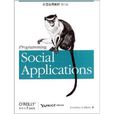《社交套用編程(影印版)》給你展示了如何使用開源技術和規範搭建富社交框架。你將會學到如何為已有網站創建第三方套用,如何搭建有吸引力的社交圖譜,以及如何開發產品來主導你自己的社交化體驗。《社交套用編程(影印版)》關注於開放社交平台,以及Apache Shindig、OAuth、OpenID和一些其他的工具,展示了它們是如何一起發揮作用來幫助你解決實際問題的。它的每一章節都揭示了高傳播性社交套用和平台的結構中一個新層面。
基本介紹
- 書名:社交套用編程
- 作者:勒布朗 (Jonathan LeBlanc)
- 出版日期:2012年4月1日
- 語種:簡體中文, 英語
- ISBN:7564133937, 9787564133931
- 外文名:Programming Social Applications
- 出版社:東南大學出版社
- 頁數:518頁
- 開本:16
- 定價:72.00
基本介紹
內容簡介
作者簡介
勒布朗(Jonatban LeBlanc)是一位重要的技術布道者,也是一位獲得過Emmy獎的工作在加州聖何塞的軟體工程師。他從事並推動了新興開源技術,使之有助於新的社交開發技術的採納和套用。
圖書目錄
1.Social Application Container Core Concepts
What Is a Social Application Container?
The User Profile
User Friends and Connections
The User Activity Stream
Implementing Proprietary Versus Open Standards
Proprietary Implementation
Open Source Implementation
Why This Book Covers Open Standards
The Embedded Application: Building in a Black Box
Embedded Application Security
Cross—Site Scripting
Same—Origin Policy and Older Browsers
Drive—by Downloads
Securing Applications
The External Application: Integrating Social Data
Outside the Container
Application Views
The Home View (Small View)
The Profile View (Small View)
The Canvas View (Large View)
The Default View (Any View)
Application Permission Concepts
Client—Side Versus Server—Side Applications
Using Template Systems for the Markup Layer
Using a Blended Server and Client Environment
Deferring the Loading of Noncritical Conrent
When Good Applications Go Bad
The Portable Flash Application
The Underdeveloped View
The Copycat View Application
The Oversharing Application
The Unmonetized Application
The Feed Application
Application Model Case Studies
Case Study: Friendship—Based Social Gaming
Case Study: Product Sales Applications
Case Study: Location—Based Applications
Quick—Start Tips
Understand Your Audience
Build Soaal Integration Points Early
Build with Monetization in Mind
Create Comprehensive Views That Play Off One Another
2.Mapping User Relationships with the Social Graph
The Online Social Graph
Applying the Real—Life Social Graph Online
Clustering Users Automatically
Privacy and Security
Establishing Trust
Sharing Private User Data: Opt—in Versus Opt—out
The Opt—in Sharing Model
The Opt—out Sharing Model
Understanding Relationship Models
The Follower Model
The Connection Model
The Group Model
Relationships Versus Entities
Building Social Relevance: Exploring the Facebook Social Graph
Building Upon Real Identity
Understanding the Viral Channels
Building User Groups
Avoiding Irrelevant Social Graphs
Defining Entity Likes and Dislikes Through the OpenLike Protocol
Integrating the OpenLike Widget
How the Shared Likes Appear
Conclusion
3.construaing the Foundation ofa SoaaIApplication Platform
What You'll Learn
Apache Shindig
Serring Up Shindig
Installing Shindig on Mac OS X (Leopard)
Installing Shindig on Windows
Testing Your Shindig Installation
Partuza
Requirements
Installing Partuza on Mac OS X (Leopard)
Installing Partuza on Windows
Testing the Partuza Installation
The OpenSocial Gadget XML Specification
Configuring Your Application with ModulePrefs
Require/Optional
Preload
Icon
Locale
Link
Defining User Preferences
Enum Data Types
Application Content
Defining Content Views
Inline Versus Proxy Content
Putting It All Together
4.Defining FeatureswithOpenSociaIJavaScriptReferences
What You'll Learn
Including the OpenSocial Feature JavaScript Libraries
Dynamically Setting the Height of a Gadget View
Inserting Flash Movies in Your Gadget
Displaying Messages to Your Users
Creating a Message
Positioning the Message Windows
Styling the Message and Window
Saving State with User Preferences
Setting Your Gadget Title Programmatically
Inregrating a Tabbed Gadget User Interface
The Basic Gadget
Creating a Tab from Markup
Creating a Tab from JavaScript
Gerting and Setting Information About the TabSet
Extending Shindig with Your Own JavaScript Libraries
Putting It All Together
Building the Gadget XML File
Displaying the Gadget Using Shindig
5.Porting Applications, Profiles, and Friendships
What You'Il Learn
Evaluating OpenSocal Container Support
Core Components of the OpenSocial Specification
Core API Server Specification
Core Gadget Container Specification
Social API Server Specification
Social Gadget Container Specification
OpenSocial Container Specification
Cross—Container Development and Porring
Use a Blended Client—Server Environment
Decouple Social Features from Mainstream Application Code
Avoid Using Container—Specific Tags
Porting Applications from Facebook to OpenSocial
Employ iframes for Non—Social—Application Constructs
Abstract Facebook Function Logic
Separare Visual Markup from Programming Logic
Use REST Endpoints, Not FQL
Employ a Server—Side Heavy Code Implementation
Personalizing Applications wirh Profile Data
The Person Object
Person Data Extraction Methods
Fields Available Within the Person Object
Extending the Person Object
Capturing the User Profile
Using Friendships to Increase Your Audience
Making a Request to Capture User Friendships
Putting It All Together
The Gadget Specification
The Conrent Markup
The JavaScript
Running the Gadget
6.OpenSociat Acivities, Sharing, and Data Requests
What You'll Learn
Promoting Your Applications with OpenSocial Activities
Personalizing an Applica rion Experience by Consuming Activity Updates
Driving Application Growth by Producing Activity Updates
Direct Sharing Versus Passive Sharing
Direct Sharing
Passive Sharing
Balanced Sharing
Making AJAX and External Data Requests
Making Standard Data Requests
Pushing Content with Data Requests
Using Signed Requests to Secure a Data Connection
Putting It All Together
……
7.Advanced OpenSocial and OpenSociaI Next
8.Social Application Security Concepts
9.Securing Social Graph Access with OAuth
10.The Future ofSociah Defining Social EntitiesThrough Distributed Web Frameworks
11.Extending Your Social Graph with OpenID
Index

